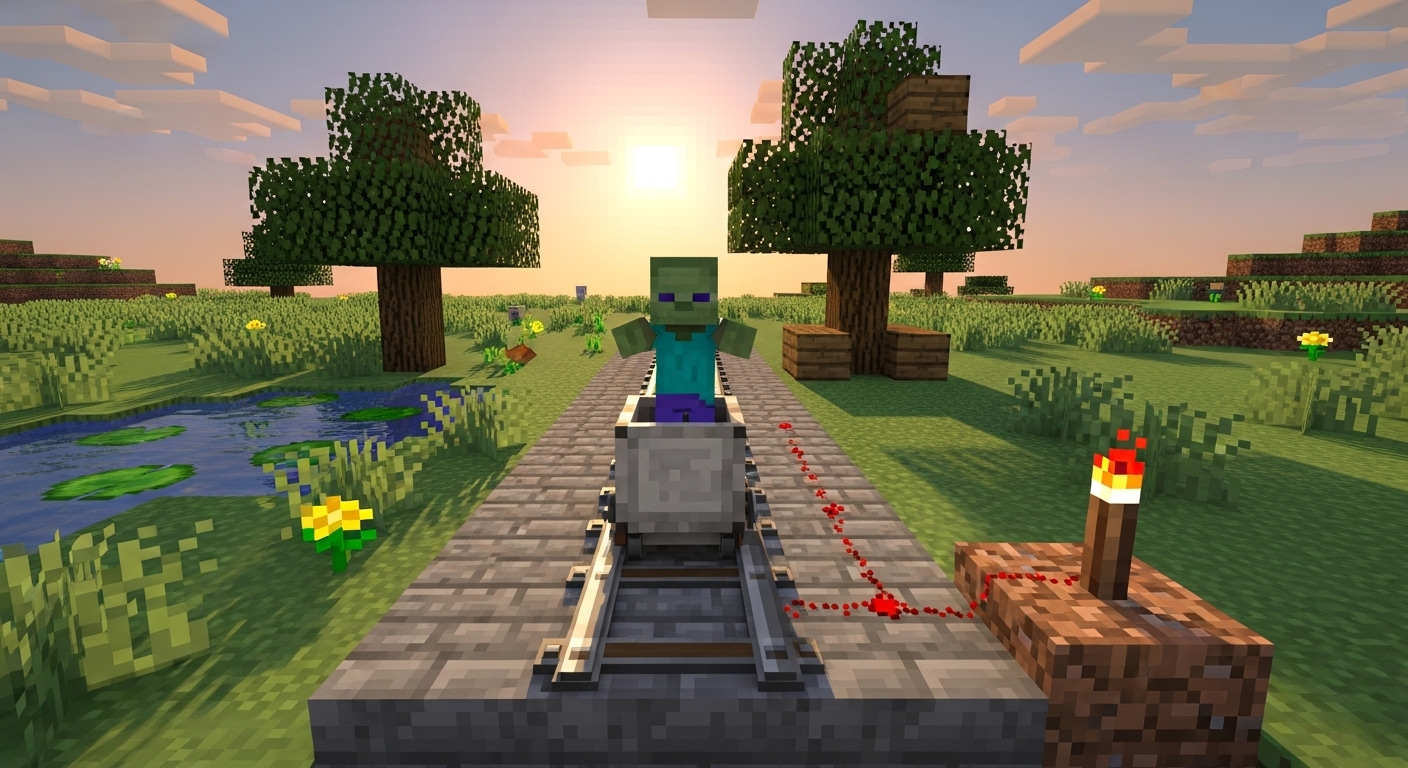The Activator Rail is a powerful redstone component that controls minecart behavior in ways no other rail can. From ejecting players to activating TNT Minecarts and toggling hopper minecarts, this rail is essential for automation, transportation systems, mob farms, and adventure map mechanics. This comprehensive guide covers crafting, mechanics, Java vs. Bedrock differences, and the most effective ways to use the Activator Rail in Minecraft.
What Is an Activator Rail?
An Activator Rail is a redstone rail block that affects minecarts passing over it whenever it receives power. Unlike Powered Rails (which affect speed) or Detector Rails (which emit redstone signals), Activator Rails directly interact with the minecart and its contents.
What Activator Rails can do when powered:
- Eject players and mobs
- Ignite TNT Minecarts
- Toggle Hopper Minecart item transfer
- Trigger Command Block Minecarts
- Interact (legacy) with Furnace Minecarts
- Apply effects without slowing or speeding carts
Natural Generation:
Unlike Powered Rails and Detector Rails found in mineshafts, Activator Rails do not generate naturally and must be crafted.
How to Craft an Activator Rail
Crafting Recipe
To craft 6 Activator Rails, you need:
| Item | Quantity |
|---|---|
| Iron Ingot | 6 |
| Stick | 2 |
| Redstone Torch | 1 |
Crafting pattern:
- Iron Ingots in the left and right columns
- Sticks in the center-top and center-bottom
- Redstone Torch in the center slot
Where to Get Materials
- Iron Ingots: Mine iron ore and smelt it, or loot from structures.
- Redstone Torch: 1 stick + 1 redstone dust.
- Sticks: Crafted from planks or obtained from leaf drops.
This recipe makes Activator Rails highly accessible early in survival mode.
How Activator Rails Work
Activation Requirements
Activator Rails only function when receiving redstone power. They can be powered by:
- Redstone torches
- Redstone blocks
- Levers
- Buttons or pressure plates (via redstone dust)
- Redstone dust on adjacent solid blocks
- Powered rails placed beside them
Redstone power rules:
- Activator Rails do not pass redstone power along the rail line.
- They do not store power like Powered Rails.
- They can be powered from below, beside, or indirectly through a supporting block.
Powered State Behavior
When powered, Activator Rails:
- Eject any entity riding a minecart (players, mobs, armor stands)
- Ignite TNT Minecarts (with precise timing)
- Toggle Hopper Minecarts, disabling or enabling item transfer
- Trigger Command Block Minecarts for executing commands
- Interact with Furnace Minecarts (Bedrock / legacy Java)
Unpowered State Behavior
When unpowered, the rail:
- Does not interact with minecarts
- Allows minecarts to pass unchanged
This is useful for areas where you need carts to move uninterrupted.
Minecart Behavior on Activator Rails
Minecart Interaction Table
| Minecart Type | Powered Activator Rail | Unpowered Activator Rail |
|---|---|---|
| Player Minecart | Ejects player | No effect |
| Mob Minecart | Ejects mob | No effect |
| Chest Minecart | No effect | No effect |
| Hopper Minecart | Toggles item transfer on/off | No effect |
| Furnace Minecart | Activates in Bedrock / legacy use | No effect |
| TNT Minecart | Ignites TNT with a short fuse | No effect |
| Command Block Minecart | Executes command | No effect |
Advanced Mechanics & Technical Details
TNT Minecart Mechanics (Important)
When ignited by an Activator Rail:
- TNT Minecarts explode after 4 game ticks (~0.2 seconds).
- Explosion strength increases with speed—a fast TNT Minecart can create a blast stronger than normal TNT.
- If an ignited TNT Minecart collides with an entity or block, it may detonate instantly.
These mechanics are used in instant-mining contraptions and trap systems.
Hopper Minecart Mechanics
When powered, Activator Rails:
- Disable a hopper minecart’s ability to pull items from blocks above
- Disable its ability to deposit items into hoppers or containers below
This makes them essential in:
- Auto-smelters
- Sorting systems
- Unloading stations
Entity Ejection Behavior
- Entities are ejected to the side of the rail, not forward or backward.
- Ejected mobs appear slightly above the rail, making mob-sorting systems reliable.
- Works on players, villagers, animals, and armor stands.
Slope & Speed Considerations
- Activator Rails work on slopes, but high-speed carts sometimes skip activation.
- For high-speed railways, place 2–3 Activator Rails in a row for reliable interaction.
- For precise automation, always place Activator Rails on flat track segments.
Placement and Redstone Tips
Best Practices for Activation
- Place a redstone torch under the block to keep the rail always powered.
- Use levers for manual toggle stations.
- Use detector rails to create automatic triggers.
- For compact builds, place a redstone block directly beneath the rail.
Redstone Power Limitations
- Redstone dust only powers rails if placed on a solid block adjacent to the track.
- Redstone signals weaken every block—repeaters may be needed after 15 blocks.
Best Uses for Activator Rails
Automatic Player Ejection Stations
Perfect for:
- Base entrances
- Villager trading halls
- Rail hubs
- Adventure maps
Players are always dropped off exactly where needed.
Minecart Unloading Stations
Activator Rails control hopper minecarts for:
- Auto-farms
- Bulk storage systems
- Furnace arrays
- Mine outputs
Toggle item flow with precision.
TNT Minecart Automation
Use for:
- Instant-mining machines
- Demolition setups
- High-powered traps
- TNT-based quarry systems
Activator Rails ensure consistent ignition.
Command Triggering (Adventure Maps)
Command Block Minecarts allow:
- Story progression
- Boss fight triggers
- Automatic teleports
- Cutscenes
- Mini-game logic
Activator Rails make these repeatable and reliable.
Mob Transportation & Sorting
Use Activator Rails to:
- Insert villagers into trading cells
- Move mobs into farms
- Sort hostile vs. passive mobs
- Place mobs in exact positions
Since entities eject cleanly, placement is predictable.
Common Mistakes to Avoid
- Confusing Activator Rails with Detector Rails
- Forgetting to power the rail
- Placing a rail on a slope where high-speed carts skip activation
- Redstone dust not connecting due to block inconsistencies
- Assuming Chest Minecarts will interact (they won’t)
Java vs. Bedrock Edition Differences
TNT Minecarts
- Bedrock Edition sometimes triggers TNT Minecarts instantly due to a known quirk.
- Java Edition uses the 4-tick ignition delay consistently.
Command Block Minecarts
- Java Edition: Executes once per activation.
- Bedrock Edition: Sometimes requires repeating rails or specific syntax to re-trigger.
Furnace Minecarts
- Java Edition: Deprecated, limited functionality.
- Bedrock Edition: Still usable; can be activated via Activator Rails.
Redstone Behavior
- Bedrock redstone updates differ slightly, occasionally requiring direct powering rather than indirect block updates.
Troubleshooting Guide
Minecart doesn’t activate the rail
- Rail is unpowered
- Redstone dust isn’t reaching the block beneath
- Cart is moving too fast on a slope
Hopper Minecart won’t pick up items
- Activator Rail powering state is disabling hopper behavior
TNT Minecart isn’t exploding
- Rail is unpowered
- Cart isn’t moving fast enough
- Rail placed on slope causing missed activation
Conclusion
The Activator Rail is one of the most versatile and powerful rail components in Minecraft. Whether you’re building a fully automated storage system, transporting villagers, designing adventure maps, or engineering TNT mining machines, mastering the Activator Rail expands what’s possible in your world. With its unique mechanics and redstone versatility, it’s a must-use tool for anyone serious about automation or rail-based infrastructure.






